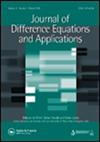Border-collision bifurcations from stable fixed points to any number of coexisting chaotic attractors
IF 1
4区 数学
Q2 MATHEMATICS, APPLIED
Journal of Difference Equations and Applications
Pub Date : 2023-10-09
DOI:10.1080/10236198.2023.2265495
引用次数: 3
Abstract
AbstractIn diverse physical systems stable oscillatory solutions devolve into more complicated solutions through border-collision bifurcations. Mathematically these occur when a stable fixed point of a piecewise-smooth map collides with a switching manifold as parameters are varied. The purpose of this paper is to highlight the extreme complexity possible in the subsequent dynamics. By perturbing instances of the n-dimensional border-collision normal form for which the nth iterate is a direct product of chaotic skew tent maps, it is shown that many chaotic attractors can arise. Burnside's lemma is used to count the attractors; chaoticity is proved by demonstrating that some iterate of the map is piecewise-expanding. The resulting transition from a stable fixed point to many coexisting chaotic attractors occurs throughout open subsets of parameter space and is not destroyed by higher order terms, hence can be expected to occur generically in mathematical models.Keywords: Piecewise-linearpiecewise-smoothborder-collision bifurcationrobust chaosBurnside's lemmaMathematics Subject Classifications: 37G3539A28 Disclosure statementNo potential conflict of interest was reported by the author(s).Additional informationFundingThis work was supported by Marsden Fund contract MAU1809, managed by Royal Society Te Apārangi. The author thanks Paul Glendinning and Chris Tuffley for discussions that helped improve the results.从稳定不动点到任意数量共存混沌吸引子的边界碰撞分岔
在多种物理系统中,稳定振荡解通过边界碰撞分岔演化为更复杂的解。在数学上,当一个分段平滑映射的稳定不动点与一个随参数变化的切换流形发生碰撞时,就会发生这种情况。本文的目的是强调后续动力学中可能存在的极端复杂性。通过扰动n维边界碰撞范式的实例,其中n次迭代是混沌斜帐篷映射的直接乘积,证明了可以产生许多混沌吸引子。Burnside引理用于计算吸引子;混沌性是通过证明映射的某些迭代是分段展开的来证明的。由此产生的从一个稳定不动点到许多共存混沌吸引子的转变发生在参数空间的开放子集中,并且不被高阶项破坏,因此可以预期在数学模型中一般会发生。关键词:分段-线性分段-平滑边界-碰撞分岔鲁棒混沌burnside定理数学学科分类:37G3539A28披露声明作者未报告潜在利益冲突。这项工作得到了马斯登基金合同MAU1809的支持,由皇家学会网站Apārangi管理。作者感谢Paul Glendinning和Chris Tuffley的讨论,帮助改进了结果。
本文章由计算机程序翻译,如有差异,请以英文原文为准。
求助全文
约1分钟内获得全文
求助全文
来源期刊
CiteScore
2.10
自引率
9.10%
发文量
70
审稿时长
4-8 weeks
期刊介绍:
Journal of Difference Equations and Applications presents state-of-the-art papers on difference equations and discrete dynamical systems and the academic, pure and applied problems in which they arise. The Journal is composed of original research, expository and review articles, and papers that present novel concepts in application and techniques.
The scope of the Journal includes all areas in mathematics that contain significant theory or applications in difference equations or discrete dynamical systems.

 求助内容:
求助内容: 应助结果提醒方式:
应助结果提醒方式:


